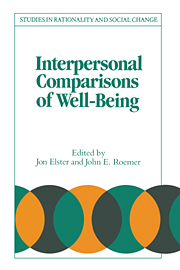Book contents
- Frontmatter
- Contents
- List of contributors
- Acknowledgments
- Introduction
- 1 The moral basis of interpersonal comparisons
- 2 Against the taste model
- 3 Utilitarian metaphysics?
- 4 Local justice and interpersonal comparisons
- 5 Notes on the psychology of utility
- 6 Adult-equivalence scales, interpersonal comparisons of well-being, and applied welfare economics
- 7 Interpersonal comparisons of utility: Why and how they are and should be made
- 8 A reconsideration of the Harsanyi–Sen debate on utilitarianism
- 9 Deducing interpersonal comparisons from local expertise Ignacio
- 10 Subjective interpersonal comparison
- 11 Utilitarian fundamentalism and limited information
- Index
2 - Against the taste model
Published online by Cambridge University Press: 05 June 2012
- Frontmatter
- Contents
- List of contributors
- Acknowledgments
- Introduction
- 1 The moral basis of interpersonal comparisons
- 2 Against the taste model
- 3 Utilitarian metaphysics?
- 4 Local justice and interpersonal comparisons
- 5 Notes on the psychology of utility
- 6 Adult-equivalence scales, interpersonal comparisons of well-being, and applied welfare economics
- 7 Interpersonal comparisons of utility: Why and how they are and should be made
- 8 A reconsideration of the Harsanyi–Sen debate on utilitarianism
- 9 Deducing interpersonal comparisons from local expertise Ignacio
- 10 Subjective interpersonal comparison
- 11 Utilitarian fundamentalism and limited information
- Index
Summary
The taste model
There are two influential models of how desire and value are related. The Perception Model gives priority to value: desired because valuable. That is, we judge or recognize something to be valuable and therefore form a desire for it. The Taste Model reverses the priority: valuable because desired. That is, given the sort of biological and psychological creatures we are, our desires come to fix on certain objects, which thereby acquire value.
Both models employ the commonplace separation of a rational side of human nature (judgment, understanding, perception) from an attitudinal side (feeling, sentiment, desire, will). One can see these attitudes either as part of a universally distributed human nature or as varying a lot between people. No doubt there is some truth in both of these views, and it is a matter of emphasis. But it is common (and, many would say, empirically plausible) to give the Taste Model the second emphasis, and I shall do that.
As these two models show, we ought to be alert to two quite different sorts of preference. Clearly, we form preferences between objects. On the Perception Model, though, I form a (derivative) preference between two options only after having independently decided on their value. No doubt some preference is like that. But on the Taste Model, desire is the basis of value. On that model I form (basic) preferences for one option over another, not derived from any independent ranking of them, just because I want the first more than the second.
- Type
- Chapter
- Information
- Interpersonal Comparisons of Well-Being , pp. 45 - 69Publisher: Cambridge University PressPrint publication year: 1991
- 15
- Cited by



